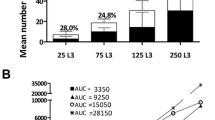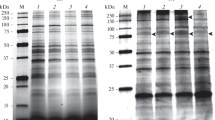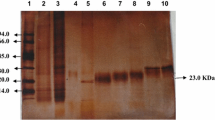Abstract
Biosynthetically radiolabelledTheileria parva schizonts were purified from bovine lymphoblastoid cells and their proteins were analyzed by two-dimensional gel electrophoresis and autoradiography. The protein spot patterns of schizont proteins from three stocks ofT. parva parva indicated that the phenotypic diversity among the stocks was minimal, with the Mariakani and Uganda stocks being identical and the Muguga stock showing only a few differences in minor spots. Comparison of the spot patterns of schizonts of threeT. parva subspecies showed thatT. p. parva andT. p. bovis differed in only one protein and thus could not be reliably distinguished on the basis of their protein differences. However,T. p. lawrencei showed several protein differences and could be distinguished easily from the other subspecies. Differences in schizont-protein spot patterns were also seen when two different cell lines were infected with the sameTheileria stabilate, when one cell line was infected with two different stabilates of the same stock and when uncloned and cloned infected cell lines were used. These results suggest the possibility that selection of phenotypically different parasites could occur in vivo or in vitro.
Similar content being viewed by others
References
Allsopp BA, Allsopp MTEP (1988)Theileria parva: genomic DNA studies reveal intra-specific sequence diversity. Mol Biochem Parasitol 28:77–84
Allsopp BA, Gibson WC, Stagg DA (1985) Characterization of some East AfricanTheileria species isolates by isoenzyme analysis, with particular reference toT. parva. Int J Parasitol 15:271–276
Anderson NG, Anderson NL (1978a) Analytical techniques for cell fractions: XXI. Two-dimensional analysis of serum and tissue proteins: multiple isoelectric focusing. Anal Biochem 85:331–340
Anderson NL, Anderson NG (1978b) Analytical techniques for cell fractions: XXII. Two-dimensional analysis of serum and tissue proteins: multiple gradient slab gel electrophoresis. Anal Biochem 85:341–354
Anderson NL, Anderson NG (1979) Microheterogeneity of serum transferrin, haptoglobin and 2-HS-glycoprotein examined by high resolution two-dimensional electrophoresis. Biochem Biophys Res Commun 88:258–265
Anderson NL, Parish NM, Richardson JP, Pearson TW (1985) Comparison of African trypanosomes of different antigenic phenotypes, subspecies and life cycle stages by two-dimensional gel electrophoresis. Mol Biochem Parasitol 16:299–314
Asao T, Kinoshita Y, Kozaki S, Uemura T, Sakaguchi G (1984) Purification and some properties ofAeromonas hydrophila hemolysin. Infect Immun 46:122–127
Brown WC, Grab DJ (1985) Biological and biochemical characterization of bovine interleukin 2. Studies with cloned bovine T cells. J Immunol 133:3184–3189
Chiles TC, O'Brien TW, Kilberg MS (1987) Production of monospecific antibodies to a low-abundance hepatic membrane protein using nitrocellulose immobilized protein as antigen. Anal Biochem 163:136–142
Conrad PA, Iams K, Brown WC, Sohanpal B, Ole-MoiYoi OK (1987a) DNA probes detect genomic diversity inTheileria parva stocks. Mol Biochem Parasitol 25:213–226
Conrad PA, Stagg DA, Grootenhuis JG, Irvin AD, Newson J, Njamunggeh REG, Rossiter PB, Young AS (1987b) Isolation ofTheileria parasites from African buffalo (Syncerus caffer) and characterization with anti-schizont monoclonal antibodies. Parasitology 94:413–423
Dobbelaere DAE, Spooner PR, Barry WC, Irvin AD (1984) Monoclonal antibody neutralizes the sporozoite stage of differentTheileria parva stocks. Parasite Immunol 6:361–370
Howard RJ, Aley SB, Lemkin PF (1983) High resolution comparison ofPlasmodium knowlesi clones of different variant antigen phenotypes by two-dimensional gel electrophoresis and computer analysis. Electrophoresis 4:420–427
Irvin AD (1987) Characterization of species and strain ofTheileria. Adv Parasitol 26:145–197
Irvin AD, Dobbelaere DAE, Mwamachi DM, Minami T, Spooner PR, Ocama JGR (1983) Immunization against East Coast fever: correlation between monoclonal antibody profiles ofTheileria parva stocks and cross immunity in vivo. Res Vet Sci 35:341–346
Kurtti TJ, Munderloh UG, Irvin AD, Buscher G (1981)Theileria parva: early events in the development of bovine lymphoblastoid cell lines persistently infected with macroschizonts. Exp Parasitol 52:280–290
Melrose TR, Brown CGD (1979) Isoenzyme variation in piroplasms isolated from bovine blood infected withTheileria parva andT. annulata. Res Vet Sci 27:379–381
Melrose TR, Brown CGD, Sharma RD (1980) Glucose phosphate isomerase isoenzyme patterns in bovine lymphoblastoid cell line infected withTheileria annulata andT. parva, with an improved enzyme visualisation method using meldola blue. Res Vet Sci 29:298–304
Melrose TR, Brown CGD, Morzaria SP, Ocama JGR, Irvin AD (1984) Glucose phosphate isomerase polymorphism inTheileria annulata andT. parva. Trop Anim Health Prod 16:239–245
Minami T, Spooner PR, Irvin AD, Ocama JGR, Dobbelaere DAE (1983) Characterization of stocks ofTheileria parva by monoclonal antibody profile. Res Vet Sci 35:334–340
Morrison WI, Goddeeris BM, Teale AJ, Baldwin CL, Bensaid A, Ellis J (1986) Cell-mediated immune responses of cattle toTheileria parva. Immunol Today 7:211–216
Morrison WI, Goddeeris BM, Teale AJ (1987) Bovine cytotoxic T cell clones which recognize lymphoblasts infected with two antigenically different stocks of the protozoan parasiteTheileria parva. Eur J Immunol 17:1703–1709
Morzaria SP, Irvin AD, Taracha E, Spooner PR, Voigt WP, Fujinaga T, Katende J (1987) Immunization against East Coast fever: the use of selected stocks ofTheileria parva for immunization of cattle exposed to field challenge. Vet Parasitol 23:23–41
Musisi FL, Kilgour V, Brown CGD, Morzaria SP (1981) Preliminary investigations on isoenzyme variants of lymphoblastoid cell lines infected withTheileria species. Res Vet Sci 30:38–43
Mutugi JJ, Young AS, Maritim AC, Ndungu SG, Mining A, Linyonyi A, Ngumi PN, Leitch BL, Morzaria SP, Dolan TT (1989) Immunization of cattle against theileriosis in Coast Province, Kenya: laboratory evaluation of a largeTheileria parva parva stabilate for use in infection and treatment immunization in the field Res Vet Sci (in press)
Pearson TW, Anderson NL (1983) Use of high-resolution two-dimensional gel electrophoresis for analysis of monoclonal antibodies and their specific antigens. Methods Enzymol 92:196–220
Radley DE (1978) Immunization against East Coast fever by chemoprophylaxis. In: Research on tick-borne diseases and tick control, Kenya, Tanzania, Uganda. Technical Report 1, AG:DP/67/077. FAO, Rome, pp 37–38
Shapiro SZ, Fujisaji K, Morzaria SP, Webster P, Fujinaga T, Spooner PR, Irvin AD (1987) A life cycle stage-specific antigen ofTheileria parva recognized by anti-macrochizoni monoclonal antibodies. Parasitol 94:29–37
Shiels B, McDougall C, Tait A, Brown CGD (1986) Antigenic diversity ofTheileria annulata macroschizonts. Vet Parasitol 21:1–10
Sugimoto C, Conrad PA, Ito S, Brown WC, Grab DJ (1988) Isolation ofTheileria parva schizonts from infected lymphoblastoid cells. Acta Trop (Basel) 45:203–216
Tait A (1981) Analysis of protein variation inPlasmodium falci parum by two-dimensional gel electrophoresis. Mol Biochem Parasitol 2:205–218
Uilenberg G (1981) Theilerial species of domestic livestock. In: Irvin AD, Cunningham MP, Young AS (eds) Advances in the control of theileriosis. Martinus Nijhoff, The Hague, pp 4–37
Author information
Authors and Affiliations
Additional information
II RAD publication 641
Rights and permissions
About this article
Cite this article
Sugimoto, C., Conrad, P.A., Mutharia, L. et al. Phenotypic characterization ofTheileria parva schizonts by two-dimensional gel electrophoresis. Parasitol Res 76, 1–7 (1989). https://doi.org/10.1007/BF00931063
Accepted:
Issue Date:
DOI: https://doi.org/10.1007/BF00931063




